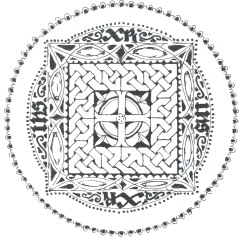



The Parish Church of St George the Martyr, Waterlooville

A Christian Mandala
Winter and Lent Edition 2010
Recently at church an Advent display was constructed. This consisted of a set of tableaux where the visitor was enjoined to select a pebble and contemplate on its provenance, to light a candle and ponder the duality of light/dark, good/evil and other dichotomies, to write on paper a prayer, a short phrase or aphorism. There were other stations in similar vein. The principle object was of contemplation, reflection, private study, thoughts and revelation through personal introspection and experience. Many found this process very enriching.
In the same way meditating on an object of focus can lead to enhanced spiritual awareness. It appears that such objects -
Christianity is the basis of the making of many Mandalas, and they are present in many other religions. Carl Jjung the psychotherapist made and used them -
Rod has designed this Christian Mandala, [see facing page] in which the viewer is invited to contemplate the meanings which it contains. Within the circular design and square within, will be found Christian symbols and allusions which could form the start points of trains of thought (even that described as woolgathering or daydreaming).
Rod Dawson
